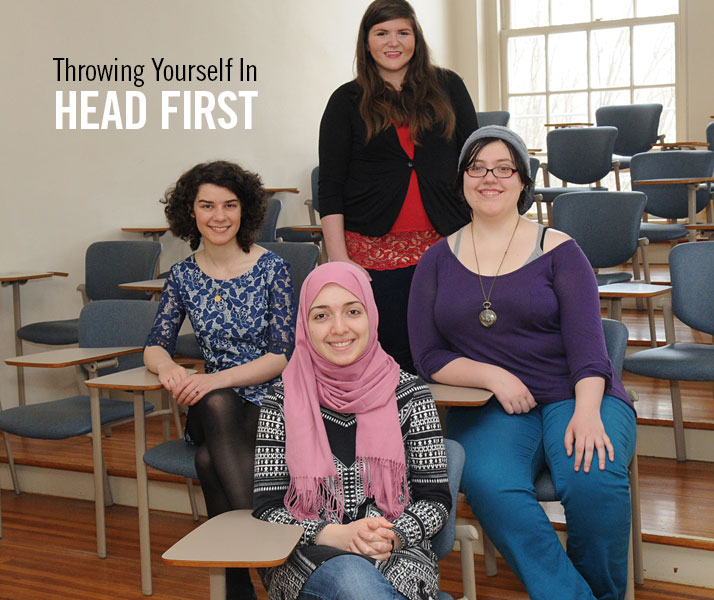
Throwing Yourself In Head First
Students from each of the four academic divisions are working on sophisticated and in-depth research, putting into practice Hollins’ hallmarks of creativity, critical thinking, and effective self-expression.
By Jeff Hodges M.A.L.S. ’11
Tinker Day, Ring Night, Hundredth Night—and student research? That might not come immediately to mind when you’re listing Hollins traditions, but it should. Throughout its history, Hollins has encouraged and celebrated original work—and students have responded with creativity and enthusiasm.
The class of 2015 is no exception. From their first year forward, students say they receive the tools they need to conduct research in any field. Their projects in turn reflect the breadth and depth of learning that takes place inside and outside our classrooms.
Here are some examples of the exceptional work this year from each of Hollins’ four academic divisions.
HUMANITIES
Lindsey Narmour ’15, English
“O that you would kiss me with the kisses of your mouth!”
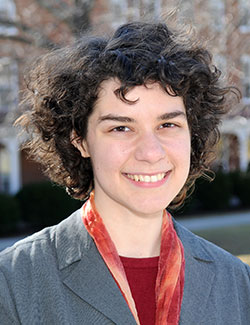 So begins the Old Testament’s provocative Song of Solomon, or Song of Songs. Christian author and scholar Harold Lindsell described it as “an idyll of love and courtship” and “[a] remarkable book. It is regarded by some as a type of allegory, while others look upon it as a drama.”
So begins the Old Testament’s provocative Song of Solomon, or Song of Songs. Christian author and scholar Harold Lindsell described it as “an idyll of love and courtship” and “[a] remarkable book. It is regarded by some as a type of allegory, while others look upon it as a drama.”
The Song of Songs has long been Lindsey Narmour’s favorite book of the Bible. The English major from Ferrum, Virginia, also has a keen scholarly interest in the medieval period. Her honors thesis, “Dark Sacred Night: The Song of Songs and Erotic Discourse in Medieval Literature,” blends those two passions and explores how the song influenced the propagation of eroticism in the 12th and 13th centuries.
“I was surprised at the extent to which erotic imagery is prevalent in medieval writing,” she says. “Interest in the song surged during this time, as did the use of erotic imagery to portray God and the individual. St. Gertrude the Great wrote about feeling God was her lover and being overwhelmed and consumed with ecstatic passion for Him.
“This occurred despite the denigration of sex by the church. [French philosopher Michel] Foucault said the more you repress something the more it’s going to come up in different ways. I think that’s what happened during this period.”
Narmour began her thesis last summer during five weeks of study at England’s University of Oxford. “The Oxford experience enriched the project, if only for the fact that I was in the place where certain things were written. I also talked with several tutors who specialize in medieval literature, and they offered suggestions on how to frame my thesis, narrow my focus, and decide which authors I should include.”
She also credits Hollins Professor of English Marilyn Moriarty with helping her construct, hone, and revise her thesis. “Professor Moriarty is very good at balancing constructive criticism with encouragement.”
One of the biggest lessons Narmour has learned is “taking things in stride. Because I’d like to be an academic, it’s easy for me to compare my work with what I’m using as sources. That isn’t a fair comparison. So I’m trying to put things in perspective. This is good ground work for what I hope to do in my graduate studies and hopefully someday as a professor of English specializing in medieval literature.”
SOCIAL SCIENCES
Victoria West ’15, communication studies and political science
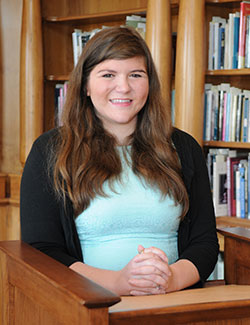 From Ronald Reagan following the explosion of the Challenger space shuttle to Bill Clinton in the aftermath of the Oklahoma City bombing and George W. Bush in the wake of 9/11, presidents in recent years have embraced the role of what PBS’s Jim Lehrer called “comforters-in-chief” during times of tragedy to both console and unify the nation.
From Ronald Reagan following the explosion of the Challenger space shuttle to Bill Clinton in the aftermath of the Oklahoma City bombing and George W. Bush in the wake of 9/11, presidents in recent years have embraced the role of what PBS’s Jim Lehrer called “comforters-in-chief” during times of tragedy to both console and unify the nation.
Communication studies and political science major Victoria “Tori” West, from West Columbia, South Carolina, was surprised that few people have studied how frequently Barack Obama has been called upon during his presidency to help the nation deal with horrific events, and how his approach differs from his predecessors’. Her honors thesis, “Healing Through Hope: A Rhetorical Analysis of Barack Obama’s National Eulogies,” examines his addresses following the Sandy Hook school shooting, the Boston Marathon bombings, and the Texas fertilizer plant explosion.
“Past presidents have made the victims of these tragedies heroes as a way to reclaim them and reclaim America’s strength, especially after a terrorist attack,” West explains. “With Sandy Hook, Boston, and Texas, Obama focused more on the survivors of these tragedies and encouraging all of us to move forward. He’s big on the rhetoric of hope and looking to a more positive future.”
West says she fell in love with analyzing presidential rhetoric when she completed an independent study during her sophomore year on Obama’s inaugural addresses. “It brought together my two majors and helped me grow my research capabilities,” she says. She believes Hollins’ commitment to teaching students advanced research skills very early in their college careers “puts us ahead of a lot of other people. It’s invaluable. And in a liberal arts environment, you get to apply these skills to a wide range of topics. You gain adaptability.”
During her sophomore year, West was the youngest presenter at the Student Undergraduate Research Forum (SURF), which featured participants from Hollins, Lynchburg, Randolph, Hampden-Sydney, and Sweet Briar. She presented her inaugural address research the following year at SURF and was the only non-senior to win an award (second place). “Competing against all those seniors was a confidence-building experience,” she says.
West returned to SURF this year to present “Healing through Hope” and received Honorable Mention. She also delivered her thesis at the Eastern Communication Association’s Undergraduate Scholars Conference and the 2015 Hollins Student Conference. During an internship this spring with the Town of Christiansburg, Virginia, she applied her research abilities to real-world projects. “Being able to perform my own research is an essential skill in the job force,” she says. She plans to pursue a career in public relations.
Natural Sciences and Mathematics
Mennatallah AlBarqi ’15, biology
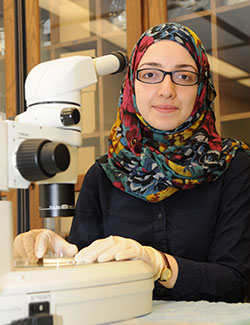 The World Health Organization estimates that 30 to 100 million people worldwide are infected with an intestinal disorder called strongyloidiasis. Occurring primarily in tropical and subtropical regions, the disease thrives in places where sanitation is poor and clean drinking water is scarce. Coughing, nausea, and stomach upset are the common symptoms. Left untreated, the disease can be fatal.
The World Health Organization estimates that 30 to 100 million people worldwide are infected with an intestinal disorder called strongyloidiasis. Occurring primarily in tropical and subtropical regions, the disease thrives in places where sanitation is poor and clean drinking water is scarce. Coughing, nausea, and stomach upset are the common symptoms. Left untreated, the disease can be fatal.
Last summer, senior biology major Mennatallah “Minna” AlBarqi, from Palestine, worked with scientists at the University of Pennsylvania who are studying the intestinal parasitic worm that causes strongyloidiasis. She continued her research during Short Term this year and presented her findings during the annual Hollins Science Seminar. Ultimately, the data AlBarqi and her fellow researchers collect will be published in a scientific journal.
“Our goal is finding an agent that will prevent this disease,” she explains. “Medication is available for treatment, but a lot of people who get sick in poorer countries simply cannot afford it and end up dying.”
AlBarqi cites the scientific environment at Hollins as the foundation for her opportunity to conduct world-class research. When she first enrolled, she says she didn’t think a small school would offer any advantages in the sciences.
“But the more I looked at what students at larger schools were experiencing I realized it wasn’t the same. Our labs are run by faculty, not by teaching assistants or grad students. And I really prefer our smaller class sizes. In both settings, professors are always available to answer your questions and provide one-on-one guidance.”
One such professor who has played a pivotal role in AlBarqi’s development as a researcher is Visiting Assistant Professor of Biology Jonathan Stoltzfus. His collaboration with the principal investigator in the Penn study helped pave the way for AlBarqi to join the project. “He was really passionate about it, and when that happens, you can’t help but get interested,” she says.
”The research I’ve done has taught me how to formulate and ask questions, and how I can develop ideas and experiments to answer those questions,” she says. “That’s what you’re supposed to learn in a Ph.D. program, so I’ve gotten a head start.”
AlBarqi will be enrolling in the biomedical sciences graduate program at the University of Massachusetts Medical School this fall and plans ultimately to do genetic research. She is confident the skills she’s learned at Hollins and Penn have given her an important edge.
Fine Arts
Kyri Lorenz ’15, studio art
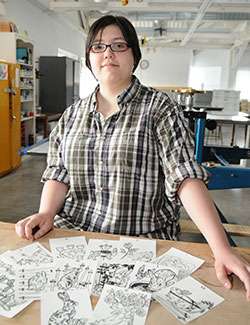 Don’t be surprised if studio art major Kyri Lorenz is someday mentioned in the same breath as Dan Santat, Brian Floca, Jon Klassen, and Erin E. Stead, children’s book writers and illustrators who all won Caldecott Medals in recent years.
Don’t be surprised if studio art major Kyri Lorenz is someday mentioned in the same breath as Dan Santat, Brian Floca, Jon Klassen, and Erin E. Stead, children’s book writers and illustrators who all won Caldecott Medals in recent years.
The senior fell in love with relief printmaking during a first-year Short Term class. Now, Lorenz is using that creative zeal and the experience gained from collaborative relationships with Hollins faculty to pursue a career in children’s book and young adult fiction illustration after graduation.
“I’m moving to Boston, where there are a lot of publishing houses,” the Estes Park, Colorado, native says.
Lorenz’s artistic evolution at Hollins is culminating with a senior thesis exhibition called Leporcalia. It’s inspired by a longtime interest in Tarot.
“As a hybrid of art and spirituality, Tarot fascinates me. So I decided to make my own deck of cards,” Lorenz says. Rabbits dominate the deck’s imagery “because they’re very complex creatures. They are in the wild but also domesticated. As a result, each culture has different associations and mythology behind what the rabbit means. Those interpretations say a lot about the people in those cultures.”
Leporcalia is the most challenging project Lorenz has undertaken. “There are 78 cards. I completed the ‘minor arcana,’ the numbered cards, pretty quickly. But the ‘major arcana’ are the cards people generally visualize when they think of Tarot—the judgment card, the tower, the star, the high priestess. Those are more complicated in terms of symbology and meaning. I also wanted to ensure my compositions aren’t just copying the originals.”
Lorenz has benefited from the guidance of Associate Professor of Art Jennifer Anderson, who has been both a mentor and colleague. “I’ve worked closely with Professor Anderson on several initiatives. We did printmaking with area middle school students for a display in a local public library, and we conducted a workshop with Carilion Clinic to create an exhibition for their Healing Arts Gallery.”
Another of Lorenz’s achievements was participating in “New Voice, Young Innovation” at the Jacksonville Center for the Arts in Floyd, Virginia. The 2014 exhibition showcased the talents of artists from area colleges.
“Making art is hard work and involves a time commitment,” Lorenz says. “It doesn’t just happen magically. But in this inspirational community, the process is so engaging that you throw yourself in head first. You get so invested, you almost don’t realize that you are growing and getting better at it.”
Jeff Hodges is director of public relations.
